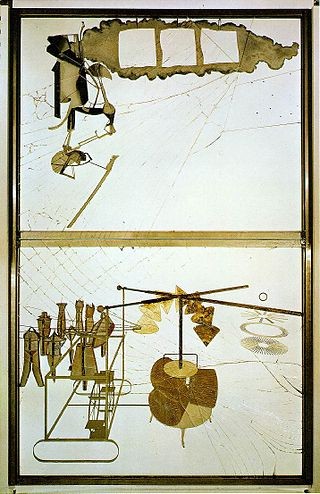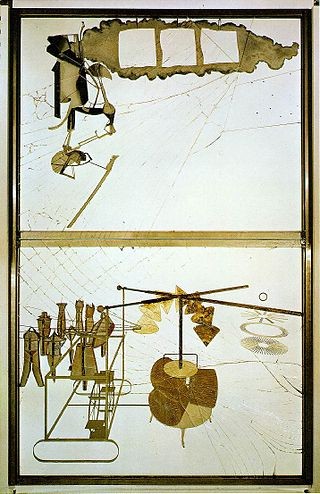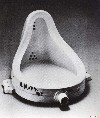Marcel Duchamp's Enigmatic Art
Champing at the Bit to take a bite out of the Champ
By: Martin Mugar - Jul 07, 2012
Duchamp studies are the terrain of some of the brightest minds writing about art today. His ideas are so universally championed in art academia I am quite fearful of being pilloried or more likely ignored for what will appear to be pedestrian ideas about the subtleties of his thought.
I can only deal with this hero of the avant-garde from my own anecdotal experience toiling in the fields of artopia. From an accumulation of observations I will try to sort out why his influence is probably more pervasive now than ever before. I would have liked to deal with the issue in a more scholarly fashion but am champing at the bit to get to the suffering inflicted by his acolytes on anyone who still believes in painting.
Duchamp’s legacy functions on multiple fronts. Philosophically it is grounded in the 20th century project to deconstruct representation. This is not just visual representation to which it is obviously related but philosophical representation, which believes that the truth of what we represent gains its validity in the coherence of our consciousness.
Originally that coherence was rooted in the onto- theological ground of God’s infallibility and humanity being created in the image of God. The work of Descartes places that coherence in the logic of mathematics. Even then he leaves God in the picture albeit in the background. His famous dictum “Ego Cogito ergo Sum” translates: Cognition makes me who I am and everything I can think about gains its validity in the clarity of that cognition, which is most evident in mathematics.
From the Baroque through the beginning of the 20th century is the period of Western egoism; I will never forget the segment from Herzog’s “Aguirre the Wrath of God” who descends the Amazon and lays claim to everything that he passes by on his canoe. At that point in the film the conquistador is alone and helpless.
Perspective, which radiates from a fixed view and its power to subsume everything in its gaze, is the visual paradigm for this era. Versailles’ s gardens are laid out on a perspective system radiating from the bed of the Sun King himself, Louis the XIV. But most of all it is the canvas and the use of Chiaroscuro which orders whatever the human eye lays its eyes on. From the use of the camera obscura in Vermeer and Caravaggio to the study of color theory in the Impressionists the eye/self brings order to all it sees.
This coherence begins to break down in the late 19th c into the 20th c with Freud’s theories that puts the ego in the vise of Eros and the superego. The Copernican revolution continues to devolve man from the center of the universe. Quantum mechanics puts in question the notion of a fixed reality that we can pin down.
If you look at the art world of the late 19th century (which is on display for the first time in Paris’s Petit Palais) you see a sort of schizophrenia developing where the followers of the Salon and Courbet continue the representation of the world from the perspective of the individual but creeping into the work is a lot of emotional baggage that is not well contained in the format of realism. Impressionism is already dissolving that fixed reality and cubism is waiting in the wings to use Cezanne’s version of impressionism to create a language that integrates time and space in a way that leaves one point perspective behind for good.
Duchamp joins this revolution with his “ Nude descending the staircase” .It is an incredibly masterful treatment of this Heraclitian view of the world, where nothing stays the same. Unlike Cubists Braque and Picasso, who remain within the tradition of painting on canvas for the rest of their careers, he sees even his masterpiece as part of the optically based language of western painting that must be extirpated.
The canvas as a mirror to the world and its long reign in Western art for him has to come to an end. What better artifact to use than transparent glass that reflects nothing and captures erotic odds and ends like amber traps insects.
I get the feeling of a Bolshevik like Strelnikov in Doctor Zhivago who wants to destroy all the trappings of Chekovian Bourgeois culture. Symptomatically, he is on the right side of history. Who can look at the images of Sargent’s imperious lords and ladies of baronial splendor and not feel the ending of an era. Those society portraits convey a sense of irrelevance and that the future will be in the hands of those who can manipulate mass culture like Lenin, Stalin, Hitler and FDR.
Several years ago I was recommended for a grant or, as a fellow artist said, recommended for a rejection. The only compensation for this rejection was a gift of a catalogue of the winners. More than half of the winners were installation artists. That was not the case forty years ago when I did my graduate work at Yale. The population of students was divided between the figurative acolytes of William Bailey and the minimalist followers of Al Held. Judy Pfaff, as a grad student, was already beginning to attach things to her canvasses, which lead to her explosive installations several years later. She is one of the few installation artists who remain close to the language of painting and sculpture. I remember her at Yale attaching wires to the paintings, which had a kind of tensile strength that had its origins in sculpture.
This shift to installation is abetted by Duchamp’s preference for the readymade. Here the displacement from the creations of the individual genius, to utilitarian objects made by consensus in factories, is another acknowledgement that we live in a corporate and highly socialized culture. It is this gesture that sets the stage for installation art where the artist tries to take the pulse of the culture through the artifacts that it creates. Warhol is pure Duchampian in his preference for images and objects of mass-production. The unique canvas that had once been the surface on which the individual acts of authenticity were recorded are now no more than objects of mechanical reproduction.
What permeates all this art is a kind of hipster ethos embodied by Warhol’s life which mocks the individual who thinks that the power of their private consciousness can overcome that fact that they are part of a larger social structure that manipulates them .I remember attending a lecture by Robert Longo in North Carolina which he ended with the statement that on his death bed his last thought will be to eat at Burger King.
Everything from politics, philosophy and technology militates against the power of the individual vision expressed on canvas. The psychic weight of a Caravaggio or a Van Gogh will always have their place in the museums and attract the melancholic art student lost in the waste land of modern art.
The linguistic turn from Wittgenstein to Tugendhat analyzes language as a purely social phenomena where meaning is not achieved privately but in a shared language. The space where meaning was achieved by a self-conscious bracketing in Husserl is considered a bad faith remnant of attempts to ground everything is Cartesian egoism. The inextricable web of technology of such as Facebook traps us into a fantasy of individuality. The system of social media tracks our habits the better to exploit us. And in politics individualism is only a posture assumed by certain politicians who are helpless to turn back the clock of the every expanding leviathan of the state .In the Theatre of the Absurd for Becket, the romantic hero is reduced to the sadistic character of Pozzo in Waiting for Godot .
There is a harsh honesty in the work of Duchamp . He coolly observes the demise of the bourgeois culture and its preferred vehicle for self-expression, the canvas, and gives the next generation of artist’s tools to use in their Kulturkampf. That intimate space that we observe from our own self of family friends and objects we care about, or just what it feels to be alive, is nothing compared to the enormous web of highways, internet, industry and its objects of mass production and the media we are wired into. It was first about the death of God and then the death of the self.
Issues of right and wrong only apply to how well we understand the irrelevancy of our private notions of the self. I think the battle has been won by the Duchampians not so much through the power of their irony but through a very scary, non-ironic fact that the ties to the individualism of the Renaissance onward have been forever severed by the mass culture we live in and its apparatchiks. All Duchamp did was provide a path for the artist to be on the right side of history.
What Nietzsche said of Christ applies to Duchamp: There was only one true Christian and he died on the cross. No one except maybe Warhol will ever match the icy cerebral operations that he enacted. Even in the world of theatre, Becket his closest parallel, seems warm hearted in comparison. His objects resist being turned into aesthetic objects, which you can’t say for Warhol’s. Rauschenberg’s deconstructions of the canvas look a little musty to me these days.
In a previous essay on BFA I commented that the little pasture of Duchamp has expanded into an infinite steppe including world class galleries that all show the same exhibit of political commentary, a photo document on the wall, and readymade or found object on the floor. Greenbergian aesthetics dead ended in minimalism and require as much mental contortions to figure out as Duchamp’s.The figurative resurgence of the late '60s and '70s exists in isolated cults in academia without much affect on the greater culture. So Duchampistes have the field to themselves. That it is an arid infinite steppe, there can be no doubt.”The waste land grows”.
I think the tragedy of Duchampian thinking rests in the following: in his single minded attempts to destroy painting as a mirror of reality he moved art permanently into acting as a purely societal or self critique . Put in the context of late 19th century art his assault on the canvas as mirror makes a lot of sense. That it could be enacted ad infinitum as it is by the current Duchampistes is absurd. It could be that the purity of his art objects and their resistance to aesthetic interpretation remain a lofty goal that each generation of followers aspires to. It puts a permanent damper on the use of painting as a vehicle for expressing any great intuitive insights into the shape of our universe as we saw in Piero de la Francesca and Botticelli in the early Renaissance. or Cezanne and VanGogh in late Impressionism. or Hsia Kuei in the early Sung in China.
There are times to build up and times to take apart.Those who deconstruct have the wind behind them and the attempts at metaphysics can’t compete. In my readings of Duchamp I came across a reference to Becket and him playing chess together. I couldn’t help but think of Nero fiddling while Rome burned.



